|
|
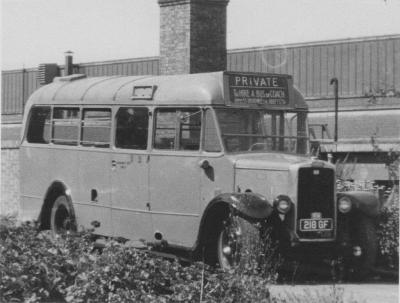 Aldenham staff buses Aldenham staff buses
Page last updated 19 June 2018
Grey-painted Cub C91 was
used in the early 50s for the Aldenham to Chiswick staff
shuttle. It is seen parked on the internal road which ran
parallel to the Watford by-pass in 1950 or 51, before the
rebuilding of Aldenham Works.
At that time, bus work was carried out in the low side
building, part of the original underground shed that was never used
as such.
Photo © Jim
Andress
We are indebted to Jim Andress and Brian Watkinson, who worked
at Aldenham in the mid-50s and from 1965 respectively, for the
following notes.
Jim Andress - a passenger's view
During the mid 1950’s, when I was an apprentice with London
Transport Road Services, I spent some six months working at
Aldenham. At that time I lived about a mile from Morden
Station and when I started travelling to Aldenham Monday to Friday
I used the Northern Line Tube to Edgware and the 18 bus from there
to Aldenham. We started work at 0730 in the morning so I had to
leave home just about 0600, cycle to the station and catch one of
the first trains out in the morning.
Travelling the full length of the Northern Line every morning
and evening soon palled and, realising there were staff buses
running from all over the Greater London Area, I made enquiries and
found the nearest to home ran from Wandsworth Garage (WD). I
then started cycling daily to Wandsworth and travelling to and from
Aldenham by STL. This service was manned by two Aldenham workers,
engineering fitters I believe, who took it in turns to drive and
conduct. We followed an interesting route from Wandsworth which
took us over Wandsworth Bridge, at that time only recently, I
believe, re-opened after being struck by a ship. The bridge was
also famous in bus circles because at around the same time a swan
flew into an upper deck window showering the occupants with
glass.
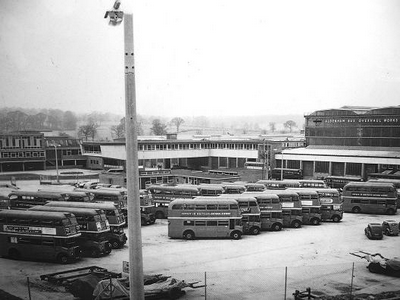 From Battersea Bridge the route took us up North
End Road, where there was a daily market, across Holland Park
Avenue, through Ladbrooke Grove, then round the back of Willesden
Garage (AC) and up via Honeypot Lane past Kingsbury and Queensbury
to Stanmore then past Stanmore Station to Canons Park roundabout
where we turned left up Brockley Hill and over the crest to cross
the roundabout at the Watford by-pass and into Aldenham. From Battersea Bridge the route took us up North
End Road, where there was a daily market, across Holland Park
Avenue, through Ladbrooke Grove, then round the back of Willesden
Garage (AC) and up via Honeypot Lane past Kingsbury and Queensbury
to Stanmore then past Stanmore Station to Canons Park roundabout
where we turned left up Brockley Hill and over the crest to cross
the roundabout at the Watford by-pass and into Aldenham.
Aldenham in its heyday. In 1955 the
'pre-war' RT2s (actually built in wartime) were withdrawn and many
were used as staff buses - at least 24 are seen in this view of the
staff bus park at Aldenham. Some newly-overhauled Green Line
RFs are in the distance. The famous 'high bay' in which body overhauls took place is
to the right of the picture.
Photo Chris Stanley collection
Most days nothing dramatic happened to disrupt the peaceful, if
boring, routine which was at least much less boring than looking at
the walls of the Tube for about an hour each way. There were days
when things did not go quite to plan however: I remember we set off
one night only to be stopped almost immediately because a lorry
going round the by-pass roundabout had shed virtually its entire
load of crates of empty glass milk bottles which meant we had to
wait until the glass was all cleared up. Another night our
driver decided he would overtake another STL going down Brockley
Hill, which in those days was little more than a lane barely wide
enough for two buses. In order to get sufficient speed he had to
put the bus into neutral and let gravity take it down well above
the maximum governed speed, needless to say there was a great sigh
of relief when we got past and the driver managed to reduce speed
again so we could turn right at Canons Park. He never did that
again while I was on the bus.
We often got delayed to a greater or lesser extent getting
through the market at North End Road on our way home and this was
made more interesting one night when shortly before arriving there
the engine suddenly died back to idling and we ground to a halt,
with, as you may imagine a chorus of barracking from the
passengers. It transpired that the accelerator linkage had become
disconnected between the pedal and the fuel injection pump. After
some discussion it was decided that the only way we could continue
was for the “conductor” to sit on the front wing and operate the
fuel pump through one of the openings in the bonnet side. We
therefore got going again, through the market towards Wandsworth.
An amusing incident during this part of the unusual journey was to
see a Policeman standing by a road junction, where we stopped for
traffic lights, do a double take when he saw the “conductor”
sitting on the wing, smartly turn his back, clearly not wishing to
know anything about what these crazy people were doing. Having got
onto a clearer bit of road it was interesting to note that despite
the twin driver arrangement we did not go any slower than normal
with normal gear changing etc. and arrived home safe and sound only
a little later than usual.
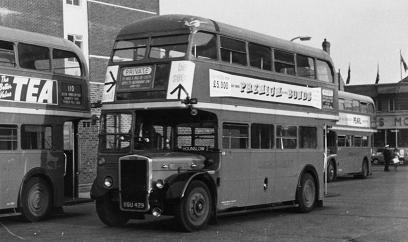 An Aldenham staff bus, RTL353, at
Hounslow. Note the draught-excluders fitted to the upper deck
front windows, and the destination slipboard. An Aldenham staff bus, RTL353, at
Hounslow. Note the draught-excluders fitted to the upper deck
front windows, and the destination slipboard.
Photo © Brian Watkinson via
London Bus
Scene
You may wonder why I was happy to cycle to Wandsworth, not that
there was much choice at that time of the morning, but I should
explain that my normal working site was Chiswick Works to which I
was in the habit of cycling for several years before I bought a
motor scooter, then motor bike and finally a car. This was despite
the fact that I could travel free on any London Transport services
but the routes between home and Chiswick, by either bus or train
were so roundabout it took over twice as long as cycling, and I had
the pleasure of going through Richmond Park on the way. In those
days, of course, there were still very few private cars in the
road, and most traffic was buses or light vans.
Brian Watkinson - the system in the 1960s
'The Aldenham staff buses formed a network of routes that
came from garages all round London making their way towards
Aldenham, picking up people on route. If you had worked at
Chiswick, Fulwell or later Charlton and been transferred to
Aldenham, you were entitled to transport and the bus was routed as
far as was possible to pick you up - many got picked up from
outside the front door! There were also other staff who had
moved home to be nearer to Aldenham during the war years when
aircraft parts were made (or Ickenham as was originally planned),
to places like Harrow, Borehamwood, Watford, Tring, Aylesbury and
St Albans and these people were also entitled to a staff bus.
Those like myself who elected to work at Aldenham after it
opened could get on a staff bus but had no right to one or even a
seat on one. You were issued with a staff bus pass
"subject to accommodation"; there were no reserved seats as such,
but woe betide you if you sat in the seat of a regular!! I
had to get the 44 bus to Wandsworth Bridge by 0635 to pick up my
staff bus, nothing ran through Battersea or Vauxhall, otherwise
nearest one was the New Cross through Camberwell Green, but that
left at 0615 from there.
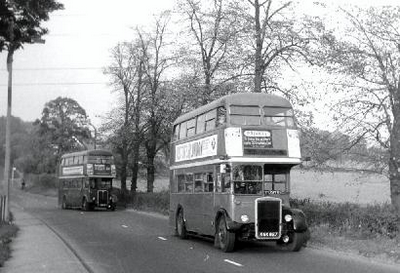 The majority of buses came from the catchment
areas of Chiswick, being the main source of the original staff,
with seven Hounslow buses, three Twickenham's, two Chiswick's
(based at Turnham Green) and one each from Mortlake, Southall,
Shepherds Bush, Putney and Sutton. The nearer to Aldenham you lived
the more buses you had passing you, but you were allocated a bus
and in theory only that bus would stop for you. The majority of buses came from the catchment
areas of Chiswick, being the main source of the original staff,
with seven Hounslow buses, three Twickenham's, two Chiswick's
(based at Turnham Green) and one each from Mortlake, Southall,
Shepherds Bush, Putney and Sutton. The nearer to Aldenham you lived
the more buses you had passing you, but you were allocated a bus
and in theory only that bus would stop for you.
Hammersmith staff bus RTL163
leaving Aldenham Works, followed by green RT1045, by then the
Southall staff bus. It is late 1969 or early 1970. In
June 1970, the Aldenham peak hours journeys on route 18 were
withdrawn, and the Shepherds Bush and Hammersmith staff buses
(which had been two of the last to leave the Works) were promoted
to 1st and 2nd and instead of the car park left from outside the
High Bay where the 18s used to park. The rest of the staff buses
could not move until these buses had passed the Car Park
exit.
Photo © Brian
Watkinson, with thanks for the extra detail
Their routes were all different. For example, the three
Twickenham staff buses followed completely different routes from
Aldenham. One I remember, Twickenham 3 followed the Mortlake down
through Stanmore, Kingsbury and Kenton Road to Harrow on the Hill,
then the Mortlake went towards Sudbury Town and Hangar Lane,
Twickenham 3 carried on through Harrow, up Sudbury Court Drive
towards Greenford, thence to Twickenham. The Sutton bus that
ran between Rose Hill and Aldenham was probably the most
distant; the Forest Gate bus also served Loughton, Walthamstow and
Clapton.
The Borehamwood buses ran from Aldenham out through
Hertfordshire almost to St Albans and back to Borehamwood
where they were securely parked up overnight. When this
facility was lost, they were returned to Aldenham. The buses
were maintained at the allocated garages, although after LCBS was
formed some buses were maintained at Aldenham.
Aldenham and Chiswick staff buses were driven by works
staff on overtime. Staff bus drivers had to have PSVs and
drove the bus from the garage to the Works, did a full day's work
then drove it back again. Typical day went from 0545 to 1815,
although many routes finished much later on Fridays due to the
traffic. The only concession was staff bus drivers were
allowed to start work at 0745 instead of 0730 and leave the shop
floor at 1600 instead of 1615. This time was officially for putting
the bus away in the mornings and checking it before it left in
the evening, in practice it was breakfast in the canteen and a cup
of tea before driving home.
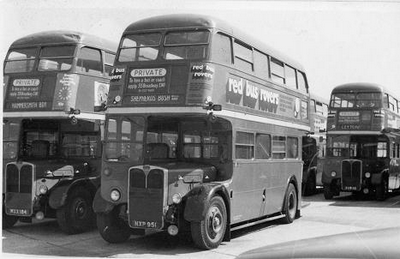 There were two drivers to each bus, one acting
as conductor when not driving. Some pairs drove one day on,
one day off, some night/morning then off. As bus driving was
a T&GWU job, staff bus drivers came from the staff in the
T&GWU at Aldenham, progress hands and assistant craftsman.
If a T&G man could not be found, the jobs were offered to
craftsman from other unions and when I started driving there were
probably more craftsman than other grades. There were two drivers to each bus, one acting
as conductor when not driving. Some pairs drove one day on,
one day off, some night/morning then off. As bus driving was
a T&GWU job, staff bus drivers came from the staff in the
T&GWU at Aldenham, progress hands and assistant craftsman.
If a T&G man could not be found, the jobs were offered to
craftsman from other unions and when I started driving there were
probably more craftsman than other grades.
The Hammersmith and
Shepherds Bush staff buses, RTs 3669 and 4809, in the car park
at Aldenham.
Photo © Brian
Watkinson
In addition to the staff bus
network, route 18 from Wembley operated to Aldenham in peak hours,
starting in October 1941. In addition to serving Works
staff, Aldenham had a hostel used by female staff from Edgware
garage (operating and canteen), as well as Aldenham catering
staff. In June 1970, this extension was withdrawn, and was
partly replaced by advancing the departure of the Shepherds Bush
and Hammersmith staff buses (which had been two of the last to
leave the Works) to 1st and 2nd, and instead of the car park left
from outside the High Bay where the 18s used to park. To use
the Shepherds Bush bus, a special pass was required, either as a
previous user, having a journey that involved main line trains from
London, or a long tube journey.
Brian Watkinson recalls 'we pulled the buses out of
the car park soon after 1600 (see photo), well before the hooter
for clocking off sounded at 1610. They were 1 and 2 in the order of
leaving and left dead on 1615 when allowed by the Warden.
When they had passed the car park gate and started to climb the
hill towards the gate, the Warden would allow the rest of the buses
to leave from the car park, all leaving in their strict running
order. One downside of being promoted from one of the last
buses to leave to the first, was the Shepherds Bush bus could get
to the garage by 1700 instead of 1715, so the drivers lost money -
so after Canons Park, we slowed down and/or did a few trips round
the Green when empty to get closer to 1715! This was
unusually early for staff buses to finish, others I drove such as
the New Cross and Sutton would regularly not finish until
1815.'
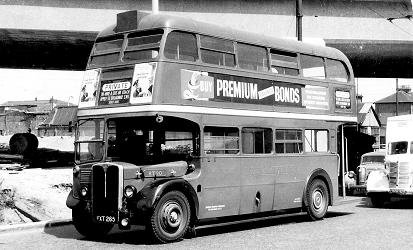
RT90 is seen circling the
brand-new Gunnersbury Roundabout in about mid-1959, under the wires
of trolleybus routes 657 and 667 and under the yet-to-be opened
Chiswick flyover (opened in September by Jayne
Mansfield). Brian Watkinson identifies this as probably one
of the spare staff buses kept at Aldenham, working the lunchtime
journey from Chiswick to Aldenham.
Photo Chris Stanley
collection
In addition to the transport of staff from and to home, there
were other runs, using a spare staff bus. These were kept at
Aldenham, in the car park normally, but were attached to
and maintained at various garages, J, CF and W were amongst
those that had them on their books. These buses were driven
by Aldenham Licensing Shop delivery drivers. One bus left
Chiswick between 0700 and 0730 and headed via the North Circular
and Sudbury Town to Edgware, arriving there just after 0805, then
on to Aldenham; it was in effect the office staff's staff bus on
this journey.
The bus left Aldenham again at
0915 to take Aldenham staff to Chiswick Works for meetings
etc. It left Chiswick again at lunchtime (I think at
1315) and went back to Aldenham - the picture of RT90 at Gunnersbury Roundabout
was probably working this service when nominally attached to
J. It then left Aldenham at 1515, essentially for Edgware to
take visiting staff and any Works staff leaving early to the Tube,
but it continued on to Canon's Park, Sudbury Town, the North
Circular and back to Chiswick. Special passes had to be
obtained for to use this bus at 1515 and these were checked by
one of the wardens. Office staff at Aldenham finished at
the same time as the Works and so used the regular staff buses to
go home, subject to accommodation.
One issue that affected staff bus allocations, as well
as training buses, was a system of 'paper allocations' which
related to the 1973 inside staff manning levels bonus
scheme. Some trainers and one or two staff buses were
only allocated on paper by Chiswick to keep garages in certain
manning level bands. So, for example, Mortlake showed two
staff buses but there was only one (the other was at AV); two
trainers were transferred to RD when it lost service buses which
meant it had dropped down a manning level band and lost staff, the
trainers put it back to its original band. These buses were
actually based elsewhere, but on the maintenance rota at the
allocated garage.
The scale of the operation is shown by the
following list of buses that were running about the time when
I started in 1965, including the spares. The RTLs that
replaced the RT2s in 1959 were all spare and had been withdrawn in
late 1958 along with many others that were sold; most had been
overhauled in 1957.
1965 Aldenham and Chiswick (where marked)
staff buses
| |
Garage |
Staff buses |
Notes |
| |
AB
|
RTL 330, 333, 338
|
|
| |
AF
|
RTL 365
|
|
| |
AL
|
RTL 314
|
Sutton staff bus
|
| |
AM
|
RTL 376, 380
|
|
| |
AV
|
RTL 345, 348, 350, 351, 352, 353,
354
RTL 435 (spare)
|
|
| |
AW
|
GS 50, RTL 406
|
Chiswick
|
| |
CF
|
RTL 367 (spare)
|
|
| |
GR
|
RT 337
|
Watford staff bus
|
| |
H
|
RTL 304
|
|
| |
HD
|
RTL 440
|
|
| |
HW
|
RTL 321
|
|
| |
J
|
RTL 399, 432
RTL 400 (spare)
|
Borehamwood staff buses
|
| |
LS
|
RTL 198
|
|
| |
M
|
RTL 368
|
|
| |
NX
|
RTL 394
|
|
| |
R
|
RTL 163
|
|
| |
RG
|
Two RTLs; by 1967, GS 21 and two
others
|
Chiswick
|
| |
S
|
RTL 371
|
|
| |
SA
|
RT 323
|
|
| |
SP
|
RTL 425
|
Chiswick (note 1)
|
| |
TG
|
RT 329
|
|
| |
TL
|
RTL 436
|
Chiswick
|
| |
V
|
RTL 339, 343
RTL 438 (spare)
|
|
| |
W
|
RTL 1332 (spare)
|
|
| |
WW
|
RTL 310, 312
|
Forest Gate and Leyton staff
buses
|
Note 1: Brian's list shows the Sidcup bus running to
Chiswick. Later in the 1960s (at least), a bus ran to
Aldenham and was used by Alan Britchford. He recalls the
route as via A41, Edgware Way, Watford Way, Great North Way, North
Circular Road, Falloden Way, Lyttelton Road, Aylmer Road, North
Hill, Highgate High Street, Dartmouth Park Hill, Brecknock Road,
York Way, Kings Cross Road, Farringdon Road, Blackfriars Bridge,
Blackfriars Road, London Road, New Kent Road, Old Kent Road, New
Cross Road, Deptford Bridge, Blackheath Road, Blackheath Hill,
Shooters Hill Road, Belle Grove Road, Hook lane, Westwood Lane,
Wellington Avenue, The Oval, Willersley Avenue, Halfway Street
(where he alighted) and presumably over the rest of the 51 route to
the garage.
The reason why RTLs were generally not used at country garages
(Luton was an exception for a while) was simply there were no
Leyland spares in Country bus stores and country bus mechanics
were not trained to maintain RTLs and so it was easier to
use old headboxed RTs.
A problem with the GSs at RG was that they were regularly
replaced by others and the staff buses were sent back to be used in
service or to be overhauled! [see the Chiswick page for more on the Reigate to
Chiswick buses].
|
|